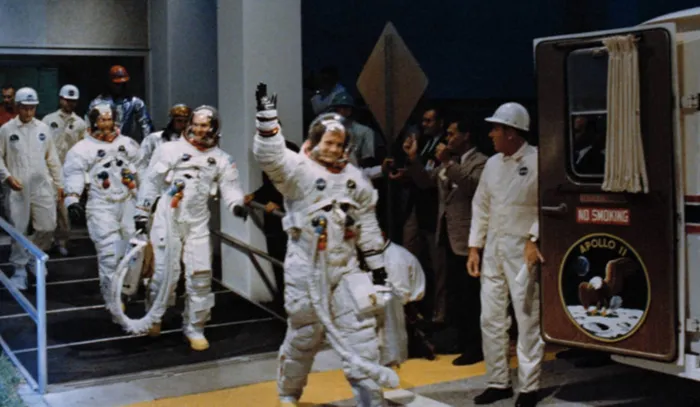To the moon and back
Exploring the myths behind the moon landing and South African conspiracy theories

Neil Armstrong, waving in front, heads for the van that will take the Apollo 11 crew to the rocket for launch to the moon at Kennedy Space Center.
Image: File photo
IN MY LAST column, I discussed a few conspiracy theories and I realised through feedback that it is a popular subject. The first was the theory that the Apollo 11 mission that landed the first humans on the moon in July 20,1969, did not take place, but was staged on a Hollywood film set.
Theory aside, let’s delve deeper into the event.
Neil Armstrong and Edwin ‘'Buzz" Aldrin became the first men to walk on the moon’s surface, while Michael Collins stayed behind and manned the lunar module.
“The Eagle had landed”. After spending 22 hours on the moon, the three lifted off and began the earthly journey.
Armstrong famously said: “That’s one small step for man, one giant leap for mankind."
But urban legend has it that he uttered another line, not as distinct, but as an aside. It has intrigued people for decades. The line was, “Good luck, Mr Gorsky."
After much investigation, the following context of that sentence was revealed. In 1938, when Armstrong was a kid in a small western town, he had apparently been playing baseball in the backyard of the family house with a friend. At one point, his friend hit the ball and it landed in his neighbour’s yard just under their bedroom window.
His neighbours were Mr and Mrs Gorsky.
As Armstrong bent down to retrieve the ball, he heard Mrs Gorsky yelling to her husband: “Sex! You want sex?... You’ll get sex when the kid next door walks on the moon.”
Apocryphal though it may be, following the moon landing, in countless subsequent interviews, Armstrong refused to verify the incident. However, he finally did so, and his motivation was that Mr Gorsky had by then passed on. So, he felt it kosher to reveal the details. Talking about kosher, the story also confirms the stereotypical belief that Jewish wives are a bit skittish on the subject of sex.
Whether the incident is true or not is now a matter lost in space, since most of the alleged role players have now shuffled off our terra firma. However, if true, it is rather a quaint story to prove the incident as fact. In the first part of this discussion a fortnight ago, I did mention that conspiracy theories are rife in the United States. Our good old South Africa is in no way innocent in this - for want of a better expression.
We have long been indulging in this pastime and they seem to have proliferated during times of social upheavals such as the HIV-epidemic and the Covid-19 pandemic. However, during the apartheid era, it was so abundant that a visiting American professor called South Africa, “the Republic of rumours”.
History seems to agree that it still IS!
One of the most peculiar conspiracy theories ran its course shortly after Nelson Mandela was released from prison. He returned to his home in Soweto for the first time in nearly 30 years. As evening set in and with the light fading, Mandela spoke to the welcoming crowd briefly in English, before going inside and closing the door.
Author Jonny Steinberg wrote: “In a section of Vilakazi Street, (where the Mandela residence was situated), that had since the late 1950s been staunchly PAC (Pan Africanist Congress, a breakaway of the ANC), it was said that the man who had come back from prison was not Nelson Mandela. The reason? Why did he choose to arrive in the dying light? And why did he avoid speaking Xhosa?”
This rumour mill continued to thrive, “claiming Mandela was killed in the late 1960s, and the man pretending to be him was an actor called Motsamai, who had been trained on a secluded farm belonging to Anglo American. The giveaway was his Xhosa; fluent, but not that of a native speaker”.
The whole incident was called a charade, which was apparently carried out by “White Capital”.
This was by no means the first ever South African conspiracy theory. These theories have a long history in Africa. Slaves created myths to explain the cruelty of white slave traders: among which included that European leather shoes were manufactured from black skin, the gunpowder of their guns was ground from African bones, that crews on slave ships fed on the boiled and salted flesh of captives, while the cheese that they ate was made from black African brains and the red wine they drank had been harvested from African blood.
The archives in Pretoria are replete with police reports in the 1920s predicting imminent uprisings, with plans to slaughter all whites. In the 1980s, it was rumoured that on a certain day all blacks would rise up and massacre every white man, woman and children. It goes on and on and on.
Journalist Bryan Rostron describes the essence of conspiracy theories with an illustration and I recall it here to conclude this discussion: In South Africa we frequently respond like the two psychiatrists passing in the corridor.
“Hello,” says one, and the other walks away worrying, “What did he mean by that?”
Conspiracy, conspiracy, everywhere and not a single one has credence!

Ravi Govender
Image: Supplied
Ravi Govender is a former POST sub-editor and Lotus FM radio presenter. He is a published author, a freelance editor and film producer in training. He can be contacted at: [email protected]
** The views expressed do not necessarily reflect the views of IOL or Independent Media.
Related Topics: